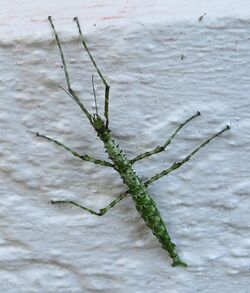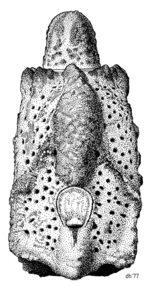Biology:Acanthoxyla prasina
| Prickly stick insect | |
|---|---|

| |
| Scientific classification | |
| Domain: | Eukaryota |
| Kingdom: | Animalia |
| Phylum: | Arthropoda |
| Class: | Insecta |
| Order: | Phasmatodea |
| Family: | Phasmatidae |
| Genus: | Acanthoxyla |
| Species: | A. prasina
|
| Binomial name | |
| Acanthoxyla prasina (Westwood, 1859)
| |
| Synonyms | |
| |
Acanthoxyla prasina, the prickly stick insect, is a stick insect in the order Phasmatodea and the family Phasmatidae.[1] It is native throughout New Zealand, although it is less frequently reported than "common" stick insect species. It has been introduced to Britain, predominantly Cornwall and Devon, and to the south-west region of the Republic of Ireland.[2][3] It has a thorny skin, which is used as camouflage.[4]
Description
Acanthoxyla prasina occurs in both green and brown colour morphs, displaying an array of black-tipped spines along its body. The species typically measures between 8 cm and 10 cm in length. Acanthoxyla prasina exclusively consists of females. Reproduction occurs without males through a mechanism called obligate parthenogenesis, which is a form of asexual reproduction. Eggs will hatch during the spring and summer and the nymphs undergo multiple molts until they reach adulthood.[5]
Distribution and habitat
Native range
Acanthoxyla prasina can be found throughout New Zealand, where it was originally endemic.[6]
Introduced range
Acanthoxyla prasina has been introduced to the United Kingdom , predominantly Cornwall and Devon, and to the south-west region of the Republic of Ireland.[2] No male had ever been seen within the species or genus Acanthoxyla until 2016 when one was discovered within the introduced population from Cornwall.[7] This single male individual was the result of a rare mutation. It is unknown if the male was capable of producing sperm or inseminating females as the specimen was killed, dried and added to part of the collection at the Natural History Museum in London.[8]
See also
References
- ↑ "Acanthoxyla prasina (Westwood, 1859)". 2021. http://phasmida.speciesfile.org/Common/basic/Taxa.aspx?TaxonNameID=1201270.
- ↑ 2.0 2.1 "Acanthoxyla prasina (National Biodiversity Network Atlas)". 2021. https://species.nbnatlas.org/species/NHMSYS0020787121#tab_mapView.
- ↑ Lee, Malcolm (1998). "An updated survey of the distribution of the stick insects of Britain". Phasmid Studies. 7 (1): 18–25. http://phasmid-study-group.org/sites/phasmid-study-group.org/files/Lee1998.pdf. Retrieved 2021-07-17.
- ↑ "Insect poses prickly questions" on Otago Daily Times website, viewed 2013-10-16
- ↑ "PRICKLY STICK INSECT Acanthoxyla prasina". 2023-06-03. https://bugoftheyear.ento.org.nz/prickly-stick-insect/.
- ↑ "Species Details". 2023-06-03. https://nztcs.org.nz/nztcs-species/33934.
- ↑ Brock, Paul D; Lee, Malcolm; Morgan-Richards, Mary; Trewick, Steven A (2017). "Missing stickman found: the first male of the parthenogenetic New Zealand phasmid genusacanthoxyla uvarov, 1944, discovered in the united kingdom". Acropos (60): 16–23. ISSN 1478-8128. http://www.atropos.info/site/index.php. Retrieved 2021-07-17.
- ↑ ainge Roy, Eleanor (2018-02-06). "New Zealand female-only stick insect produces 'rogue' male in UK". The Guardian. https://www.theguardian.com/world/2018/feb/06/new-zealand-female-only-stick-insect-produces-rogue-male-in-uk. Retrieved 2021-07-17.
External links
- Acanthoxyla prasina discussed on RNZ Critter of the Week, 17 September 2021
Wikidata ☰ Q13705567 entry
 |


